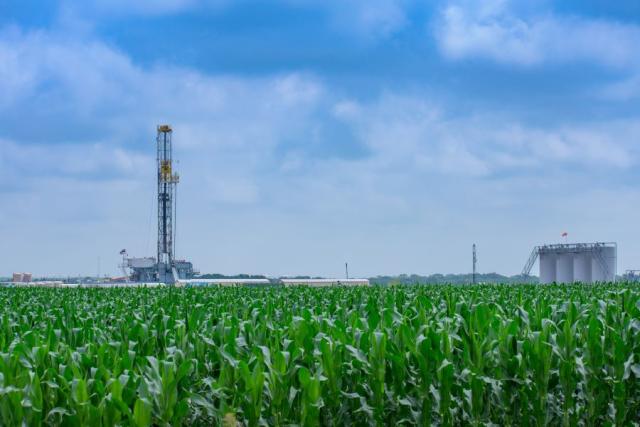
Drilling rig in Texas’ Eagle Ford shale play. (Source: Shutterstock.com)
Spanish oil giant Repsol will continue developments in the Marcellus and Eagle Ford shale during 2023 and 2024 after upping positions in both plays last year.
The company’s U.S. shale assets align with its plans to maintain and boost North America as a key business area due to the extensive existing infrastructure and regulatory framework stability.
In the Marcellus, Repsol anticipates a future investment decision (FID) related to a third phase development in 2023 following approval of two phases in 2021 and 2022, the company said Feb. 16 in its fourth-quarter 2022 press release.
Repsol acquired new Marcellus assets in 2022, adding 45,000 net acres in Tioga, Bradford and Lycoming counties, Pa., including additional production of 80 MMcf/d and future drilling locations.
In the Eagle Ford, Repsol looks to develop its remaining inventory in phases in 2024 and beyond after announcing FID for the third phase of development, which includes drilling a further 49 operated wells on 12 platforms. The wells could generate additional incremental lifetime net sales of 42 MMboe in the retrograde gas, wet gas and black oil windows, Repsol said.
Net income increase
Repsol’s recurring net income was €6.7 billion (US$7.2 billion) in 2022 compared to €2.5 billion ($2.7 billion) in 2021, with the upstream and industrial sectors turning in notable performances, the Madrid-based company said in the release. After factoring in net impacts from inventory effects and a special impairment of €2.5 billion last year, net income was €4.3 billion in 2022 compared to €2.5 billion in 2021.
The bottom line rose on higher commodity prices and appreciation of the dollar against the euro, which were partially offset by lower production due to ongoing portfolio management as well as higher E&P costs, amortization and taxes principally due to a higher operating income.
"The high energy prices we pay today are not only a consequence of the war in Ukraine. The shortage of energy products already existed before,” Repsol CEO Josu Jon Imaz said in the release. “In Europe, we are highly dependent on imports because regulators have preferred to forget the need to invest in oil and gas and in refining capacity.”
Repsol’s production was 550,000 boe/d in 2022 compared to 572,000 boe/d in 2021, down 3.8% mainly due to efforts to concentrate its E&P geographical footprint in countries and plays with competitive advantages while exiting Ecuador, Malaysia, Russia and Greece and divesting producing oil assets in Canada. Repsol now has a presence in just 15 countries compared to over 25 a year earlier.
The lower production reflects Repsol’s new upstream focus on “value over volume,” company executives stressed Feb. 16 during the quarterly webcast.
Repsol’s North American assets, including holdings in the Gulf of Mexico, represented 31% of its total production in 2022, compared to Latin America (47%) and Europe, Africa and the rest of the world (22%).
RELATED
Eni, Repsol Ready Venezuela Oil Shipments to Europe Thanks to US
Outlook for 2023
In 2023, Repsol looks to generate sufficient cash flow to support increased distributions and capex. Its budget utilizes an $80/bbl Brent price and a $4/MMbtu Henry Hub price and assumes it will generate €8 billion in cash flow from operations this year.
As part of a focus on upstream and low carbon initiatives, Repsol’s capex is set at €5 billion ($5.3 billion) in 2023, compared to €4.3 billion in 2022. 47% is destined for the upstream sector, followed by renewables (24%), industrial (23%) and commercial (6%).
Repsol also expects to dedicate 25% to 30% of its cash flow from operations to shareholder remuneration.
Cash remunerations will rise by 11% in 2023 to €0.70 gross per share. The company’s board will implement a share buyback with a maximum of 35 million shares targeted, and the board expects to redeem 50 million shares before the end of July.
Recommended Reading
Defeating the ‘Four Horsemen’ of Flow Assurance
2024-04-18 - Service companies combine processes and techniques to mitigate the impact of paraffin, asphaltenes, hydrates and scale on production—and keep the cash flowing.
Tech Trends: AI Increasing Data Center Demand for Energy
2024-04-16 - In this month’s Tech Trends, new technologies equipped with artificial intelligence take the forefront, as they assist with safety and seismic fault detection. Also, independent contractor Stena Drilling begins upgrades for their Evolution drillship.
AVEVA: Immersive Tech, Augmented Reality and What’s New in the Cloud
2024-04-15 - Rob McGreevy, AVEVA’s chief product officer, talks about technology advancements that give employees on the job training without any of the risks.
Lift-off: How AI is Boosting Field and Employee Productivity
2024-04-12 - From data extraction to well optimization, the oil and gas industry embraces AI.
AI Poised to Break Out of its Oilfield Niche
2024-04-11 - At the AI in Oil & Gas Conference in Houston, experts talked up the benefits artificial intelligence can provide to the downstream, midstream and upstream sectors, while assuring the audience humans will still run the show.






